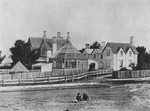Jerrabomberra Wetlands Nature Reserve is a nationally important group of small wetlands in central Canberra (the capital of Australia). The Wetlands area is on a part of the Molonglo River - Jerrabomberra Creek floodplain that became permanently inundated when the Molonglo River was dammed to form Lake Burley Griffin in 1964.
ACT Parks and Conservation Service manages the Wetlands in partnership with the Woodlands and Wetlands Trust.
Major water bodies at Jerrabomberra Wetlands include Shoveler Pool, Kelly’s Swamp, Molonglo Reach, Jerrabomberra Billabong, Jerrabomberra Creek, Jerrabomberra Pool, and a silt trap. The Jerrabomberra Backwaters are palaeochannels formed by the Molonglo River as it flooded and shifted course over geological time.
People use Jerrabomberra Wetlands for recreation, such as walking and nature walks, bird watching, and fishing. Jogging and cycling in the wetlands area are discouraged except if passing through on the main path, because they disturb fauna. Dogs are prohibited. Canoeists and kayakers use Molonglo Reach, and larger boats are allowed there via permit.
Nearby places of interest include the Kingston Foreshore (cafés), Royal Military College Duntroon, and Pialligo Estate (wineries, plant nurseries and cafés). The Woodlands and Wetlands Trust facilitates events, education and community engagement through partnerships and co-funding. New residential developments are planned for the western and southern edges of the Nature Reserve, and they will bring thousands more visitors to the Reserve.
The Jerrabomberra Wetlands Nature Reserve is a summer feeding ground for Latham's Snipe which is a relatively rare waterbird protected under the Environment Protection and Biodiversity Conservation Act 1999 (EPBC Act) and listed under the international migratory bird agreements with China (CAMBA), Japan and the Republic of Korea (ROKAMBA). Latham’s Snipe migrate between northern Asia and Australia for the Canberra winter. Jerrabomberra Wetlands are habitat for a range of other fauna, both terrestrial and aquatic, including other birds, turtles, frogs, platypus and water rats (Rakali), and snakes, as well as foxes (a predator introduced to Australia from Europe, which preys on Australian native fauna), and other pest species. Outside the reserve, birds in the area also use the nearby sewage treatment ponds and turf farm for shelter and food.








